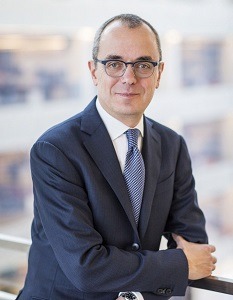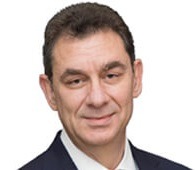Big Pharma Strategies and Growth Initiatives: What’s In Store for 2020
At the J.P. Morgan Annual Healthcare Conference in San Francisco this week, pharma industry executives highlighted their companies’ strategies and key growth initiatives. What is the latest from Pfizer, Bristol-Myers Squibb, GSK, Amgen, and others?
Inside Big Pharma’s company strategies
Bristol-Myers Squibb. Giovanni Caforio, M.D., Chairman of the Board and Chief Executive Officer (CEO) of Bristol-Myers Squibb (BMS) highlighted the company’s strategic rationale for its $74-billion acquisition of Celgene, a deal that was announced in January 2010 and completed late last year (November 2019). On a product basis, he said the acquisition provides BMS with several leading franchises in oncology, cardiovascular diseases, and immunology and inflammation.
 |
|
Giovanni Caforio, M.D. |
Key products in the combined company’s oncology franchise are BMS’ immuno-oncology drug, Opdivo (nivolumab) with 2018 global sales of $6.735 billion, BMS’ checkpoint inhibitor, Yervoy (ipilimumab) with 2018 sales of $1.330 billion, Celgene’s multiple myeloma drug, Revlimid (lenalidomide), with 2018 sales of $9.685 billion and Celgene’s checkpoint inhibitor, Pomalyast (pomalidomide), with 2018 sales of $2.040 billion. In its cardiovascular franchise, the key product is BMS’ anticoagulant, Eliquis (apixaban), with 2018 sales of $6.438 billion. In the company’s inflammatory and immunology franchise, key products are BMS’ Orcenia (abatacept), a drug used to treat autoimmune diseases, including rheumatoid arthritis, with 2018 sales of $2.710 billion, and cardiovascular led by Bristol-Myers Squibb’s anticoagulant, Eliquis (apixaban), with 2018 sales of $6.438 billion. One key product change in its immunology and inflammation franchise was the divestiture by Celgene to Amgen for $13.4 billion of Otezla (apremilast), a drug for treating moderate-to-severe plaque psoriasis and psoriatic arthritis, which was divested to as part of the conditions for approval by the US Federal Trade Commission.
In terms of new products, Caforio highlighted two approvals from the US Food and Drug Administration in 2019: Reblozyl (luspatercept-aamt) for treating anemia in adult patients with beta thalassemia, a rare blood disorder, and for Inrebic (fedratinib) for treating intermediate-2 or high-risk primary or secondary myelofibrosis, a rare form of bone marrow cancer. The company also has three recent submissions to the FDA: ozanimod, an investigational immunomodulatory drug for treating relapsing multiple sclerosis; Reblozyl MDS for myelodysplastic syndromes (MDS), a suite of rare blood cancers in which mutations prevent bone marrow stem cells from making healthy blood cells, leading to chronic anemia; and lisocabtagene maraleucel (liso-cel), an autologous anti-CD19 chimeric antigen receptor (CAR) T‑cell immunotherapy for treating relapsed or refractory large B-cell lymphoma (LBCL) after at least two prior therapies. He also noted eight potential near-term product launches, which include new drugs and new indications for existing drugs. These include a dual immunotherapy of Opdivo and Yervoy for treating certain type of lung cancer; multiple hematology launch opportunities with the potential to be first-in-class and/or best-in-class through Inrebec, Reblozyl, liso-cel, idecabtagene vicleucel (ide-cel), a CAR T therapy for treating relapsed and refractory multiple myeloma, and CC-486, an investigational maintenance therapy for treating acute myeloid leukemia; and an expanding Immunology portfolio with ozanimod and BMS-986165, an investigational oral, selective tyrosine kinase 2 (TYK2) inhibitor for treating moderate to severe plaque psoriasis.
In terms of post-merger acquisition, Caforio highlighted the company is on track to drive $2.5 billion in run-rate synergies by 2022 and that its leadership team and site footprint, including biopharmaceutical research and development hubs, are in place.
 |
|
Albert Bourla |
Pfizer. One year after taking the helm at Pfizer, Albert Bourla, Chairman and CEO, highlighted accomplishments at Pfizer. Beginning last year (2019), Pfizer reorganized into three businesses: its Biopharma business, which consists of the company’s innovative medicines business; Upjohn, its off-patent branded and generic established medicines business, which is being combined with Mylan in a deal that is expected to close in mid-2020 to create a new company with pro forma 2020 revenues of $19 billion to $20 billion; and its Consumer Healthcare business, which combined with GlaxoSmithKline’s (GSK) consumer healthcare business in a joint venture, effective August 2019. Bourla said the company is considering an initial public offering of its consumer-health joint venture with GSK in three to four years.
The pending spin-off of its off-patent branded and generic established medicines business and the formation of a consumer healthcare joint venture with GSK addressed Pfizer’s interest to re-organize lower performing assets to focus more fully on its innovative medicines business, into what has been termed as “the new Pfizer,” which through those reorganizations will be a smaller company (approximately $40 billion based on estimates) but one that includes a more targeted research and development focus. Bourla noted that the company has reduced is therapeutic focus to six areas compared to 13 in 2010. The company will hold an R&D day in March to further highlight its pipeline and progress.
 |
|
Vasant Narasimhan, MD, CEO, Novartis. |
Novartis. Vasant Narasimhan, CEO, Novartis emphasized in his presentation at the J.P. Morgan’s conference the company’s strategy of leveraging its scale and therapeutic focus, an emphasis on growth in certain geographies, such as China, where the company plans to double sales by 2024, and the importance of advanced therapy platforms (i.e., cell, gene and RNA therapies) and data science in the company’s strategy. With regard to advanced therapy platforms, the company has 16 advanced therapies in clinical development and whose position it enhanced with the $8.7-billion acquisition of the gene-therapy company, Avexis. Overall in its innovative medicines business, he said that the company is focused on launch excellence for 15 ongoing and upcoming major launches. In terms of scale and focus, Narasimhan, noted that the company has 116 projects in Phase I/II, 37 projects in Phase III, and 11 products in registration. He added that the company is maintaining its goal of achieving cost savings of $2 billion by the end of 2020.
GlaxoSmithKline. Emma Walmsley, CEO of GlaxoSmithKline (GSK), emphasized the company’s growth strategy, which includes oncology, a position, which it added to with its $5.1-billion acquisition of Tesaro in early 2019. With the acquisition of Tesaro, GSK gained Zejula (niraparib), an oral poly ADP ribose polymerase (PARP) inhibitor approved for treating ovarian cancer. In 2020, Walmsley said that the company is preparing for three oncology launches: belantamab mafodotin in relapsed/refractory multiple myeloma; Zejula in ovarian cancer maintenance; and dostarlimab in endometrial cancer. Other product approvals the company is targeting in 2020 are: its HIV combination therapy of cabotegravir and rilpivirine; fostemsavir for HIV, daprodustat for treating renal anemia due to chronic kidney disease for approval in Japan,and FDA approval for its respiratory drug Trelegy (fluticasone furoate, umeclidinium & vilanterol) for treating asthma.
 |
|
Emma Walmsley |
Amgen. Amgen Chairman and CEO Robert Bradway emphasized recent deals in the company’s growth strategy: its recent $13.4-billion acquisition of Otzela from Celgene as a key growth driver for the company and $3-billion strategic alliance in China with BeiGene. He said that the company expects 25% of its sales to be from the Asia-Pacific region over the next 10 years. Earlier this year, Amgen acquired an equity stake in BeiGene, a Beijing-based pharma company, for $2.8 billion and formed a strategic oncology-drug pact with BeiGene in China and globally. BeiGene is a commercial-stage research-based oncology company with a team in China, including an approximately 900-person commercial organization and an approximately 600-person clinical development organization. With the closing of the deal, Amgen acquired a 20.5% stake in BeiGene for approximately $2.8 billion. Under the deal, BeiGene will commercialize several Amgen drugs in China during which time the parties will equally share profits and losses. These drugs are: Xgeva (denosumab) for treating giant cell tumors of the bone; Kyprolis (carfilzomib) for treating multiple myeloma; and Blincyto (blinatumomab) for treating relapsed or refractory acute lymphoblastic leukemia. Two of these products will revert to Amgen, one after five years and one after seven years. Following the commercialization period, BeiGene will have the right to retain one product and will be entitled to receive royalties on sales in China for an additional five years on the products returned to Amgen. Xgeva was launched in China in September 2019; new drug applications for Kyprolis and Blincyto have been filed in China. In addition, Amgen and BeiGene will also collaborate to advance 20 medicines from Amgen’s innovative oncology pipeline in China and globally. BeiGene will share global research and development costs and contribute up to $1.25 billion to advance these medicines. Amgen will pay royalties to BeiGene on the sales of these products outside of China, with the exception of Amgen’s AMG 510, a KRAS (G12C) inhibitor being studied as a potential treatment for solid tumors. Amgen anticipates using data from clinical trials conducted in China to advance the development of its oncology portfolio globally.
Overall, he also noted that the company streamlined its core research focus to oncology, cardiovascular disease and inflammation while maintaining a commercial presence in six therapeutic areas.
In terms of key product growth drivers, he emphasized the following: Repatha (evolocumab) for lowering LDL cholesterol and reducing the risk of heart attack and stroke; Aimovig (erenumab) for migraines; Evenity (romosozumab) for treating osteoporosis; and the recently acquired Otezla.







